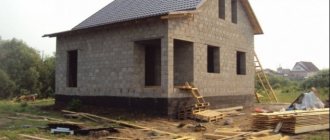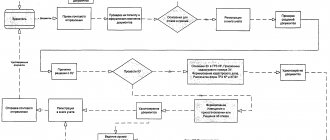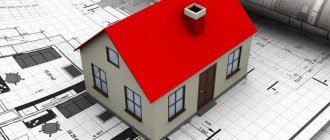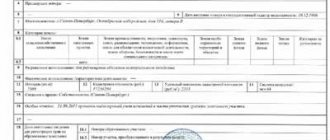A characteristic feature of unfinished construction projects is that they cannot be used for their intended purpose until they are put into operation. These include residential and non-residential fixed asset complexes. There are a number of signs of unfinished construction:
- the design is characterized by volume;
- above-ground or underground structures have been erected;
- utility lines have been installed.
How does an unfinished construction project differ from a completed construction site ?
Concept of unfinished construction
Unfinished construction is a set of expenses incurred by the developer that have accumulated from the day the facility was laid down until the date it was put into operation. Objects that are in the process of completion are tied to a specific land plot. Finished buildings and structures must be permanent; temporary buildings (kiosks with hanging structures) are taken into account separately.
How can a developer register ownership of an unfinished construction project ?
The suspension of construction may be caused by insufficient financing and a shortage of tools, raw materials, and working capital. Unfinished objects after commissioning will be recognized as fixed assets as real estate. But until the work on the facility is recognized as fully completed, the asset cannot be reflected in accounting transactions as part of fixed assets.
ATTENTION! The amount for unfinished construction is formed only from actual expenses.
What kind of house is called “unfinished”?
This is how people dubbed houses whose construction has not yet been completed . Such buildings are always cheaper than finished and commissioned houses, because we are talking about a structure in which it is not yet possible to live.
It can be just a foundation or a foundation and walls, or it can be a semi-finished house that already has a roof. In an unfinished house, all communications are often not connected.
The advantage of buying such a house is that it costs much less than a ready-made house. At the same time, there are also many pitfalls here.
The procedure for accounting for unfinished construction projects
Expenses for unfinished objects in accounting are shown as cumulative totals. The cost of constructed facilities includes:
- amounts spent on installation and construction work;
- the price of purchasing equipment for installation in a building under construction;
- costs for the development of built-up areas;
- rent payments for land;
- payment for services for preparation of design and survey documentation;
- costs directly related to construction activities for a specific task.
IMPORTANT! Assets under construction cannot be depreciated.
When receiving primary documentation, the accountant summarizes all cost items for the constructed building or structure. In general, expenses are reflected in the cost of inventory, raw materials, finishing materials, wages for workers, and fuel for equipment. If a defect is discovered during an inspection of an object, it is included in the costs.
Question: Should an organization pay property tax if it has an unfinished building on its balance sheet that is being rented out, but permission to put it into operation has not yet been received? View answer
Before putting the facility into operation, its readiness is checked. Based on its results, an Act is drawn up. The document is signed and verified with the customer. After recognizing a structure as a tangible asset in accounting, the management of the enterprise can dispose of it in the following ways:
- sell to a third party;
- make a gratuitous transfer in favor of an individual or other institution;
- initiate mothballing of an asset if it will not be used for a long time (due to seasonality of production or a forced reduction in production volumes);
- transfer for temporary use under a lease agreement.
NOTE! When deciding on the method of using the constructed objects, it is necessary to coordinate the operation with the members of the commission created at the enterprise.
The procedure for transferring an object from the category of unfinished construction to completed involves signing an Asset Acceptance and Transfer Certificate and reflecting its value in accounting. The forms of acts are given in the Goskomstat decree of November 11, 1999, No. 110. The next step is to stop recording business transactions for this facility at the stage of construction in progress. All amounts accumulated in the account are transferred to the cost of the new fixed asset put into operation.
Procedure for freezing unfinished construction
Temporary suspension of the construction of a building or structure must be documented. The decision on the need for this operation is made by the customer; it is recorded in an order indicating the timing of the inventory. At the next stage, the developer is notified of the upcoming conservation of the property.
Before freezing construction at the site, an inventory is carried out. For this procedure, a commission body is created from representatives of the customer and the contractor. After inspecting the unfinished structure, members of the commission draw up an inventory list. The document reflects:
- name of the property;
- list of structural elements;
- construction stage.
After the inventory activities, a Temporary Stop of Construction Act is signed.
Are unfinished construction projects subject to corporate property tax ?
Sale of an unfinished asset
Only an object whose construction has been suspended can be sold. Before completing a transaction, it is necessary to register ownership of the structure being constructed. To do this, a set of title documentation for the land plot and a previously issued permit to begin construction work are submitted to Rosreestr (Article 40 of the Law of July 13, 2015 No. 218-FZ). The registration authority will need additional information:
- type of property asset being built;
- percentage of completion of the structure;
- purpose of the building according to the project.
In accounting, completed work is accepted into the balance sheet, and the contract agreement is terminated.
Property tax under NZS for individuals
Until the tax period of 2021 inclusive, the personal income of individuals is taxed if three mandatory conditions are met (Article 400, subparagraph 5, paragraph 1, Article 401 of the Tax Code of the Russian Federation, letter of the Ministry of Finance dated December 14, 2017 No. 03-05-06-01/83522, dated 05/27/2015 No. 03-05-06-01/30444, information from the Federal Tax Service of Russia dated 05/31/2017, order of the Ministry of Construction of the Russian Federation dated 04/04/1992 No. 87):
- ownership of the object is registered;
- a subject of the Russian Federation has established the cadastral value as the basis for taxation or the object is taxable only on the basis of the cadastral value under Art. 378.2 of the Tax Code of the Russian Federation (administrative, commercial, residential facilities);
- the value of the object is determined.
At the same time, owners of unfinished construction projects do not have benefits that exempt them from paying taxes and do not enjoy tax deductions, with the exception of benefits and deductions established by municipal regulations at the location of the facilities.
IMPORTANT! From 2021, property tax will be calculated only based on cadastral value.
Tax rates when calculated on the basis of cadastral value depend on the purpose and cost of the unfinished object (clause 2 of Article 406 of the Tax Code of the Russian Federation):
- 0.1% - for non-construction construction of housing (by decision of local authorities, this rate can be reduced to zero or increased, but not more than 3 times);
- 2% - for public construction of administrative, commercial and expensive (more than 300 million rubles) objects;
- 0.5% - for construction works of other objects.
The maximum tax rates on the inventory value are determined only by the value of the object (clause 4 of Article 406 of the Tax Code of the Russian Federation):
- 0.1% - no more than 300 thousand rubles;
- 0.1–0.3% - from 300 thousand to 500 thousand rubles;
- 0.3–2% - more than 500 thousand rubles.
A number of individuals have the right to tax benefits (Clause 1, Article 407 of the Tax Code of the Russian Federation). In particular these include:
- people with state awards;
- disabled people;
- participants in combat operations or who have served in the army for more than 20 years;
- citizens exposed to radiation as a result of accidents;
- family members of military and civil servants killed in the line of duty;
- pensioners and pre-retirees, etc.;
- individuals using household buildings with an area of up to 50 sq. m. m.
Administrative, commercial and expensive (more than 300 million rubles) objects are not exempted (clause 5 of Article 407 of the Tax Code of the Russian Federation), and for the rest the benefit can be applied only to one property of each type at the choice of the taxpayer, provided there is documentary evidence of the right to it . Documents for the benefit are submitted to the Federal Tax Service along with an application for its provision no later than November 1 of the year for which the tax will be calculated (clause 7 of Article 407 of the Tax Code of the Russian Federation).
Objects used in business activities are also not subject to benefits. A concession can be applied to a construction project that, being unfinished, is not yet used for business purposes. However, if the Federal Tax Service Inspectorate discovers the fact of such use of the property, then a tax will be charged on this property.
Tax calculation is carried out by the Federal Tax Service and sends a notification along with a payment document to the individual taxpayer in such a way that the individual receives a set of documents for paying the tax no later than 30 days before the payment deadline (clause 2 of Article 52 of the Tax Code of the Russian Federation).
If common or shared ownership is registered for a construction site object, then all its owners will be taxpayers in equal or proportional shares, respectively (clause 3 of Article 408 of the Tax Code of the Russian Federation).
If the object arose during the tax year, then its cadastral value for tax purposes is taken as of the date of registration in the cadastre. If an error is detected in the cadastral value, the tax is recalculated from the period of such error. In case of a disputed cadastral value, tax changes are taken into account starting from the date of commencement of application for tax purposes of information about the changed cadastral value (clause 2 of Article 403 of the Tax Code of the Russian Federation).
If ownership of an object exists for less than a full year, then the calculation is made taking into account a coefficient that reduces the tax in proportion to the number of full months of actual ownership. In this case, a full month is considered to be the one in which the right of ownership arose before the 15th day or ceased after the 15th day (clause 5 of Article 408 of the Tax Code of the Russian Federation).
Also, taking into account the number of months of actual ownership of the property, the tax benefit is taken into account. In this case, the months of emergence and disappearance of the right to a benefit are considered complete (clause 6 of Article 408 of the Tax Code of the Russian Federation).
If a taxpayer who owns a property has not received a notification from the Federal Tax Service to pay the tax, and they never came to him, he needs to inform the tax inspectorate about the existence of the taxable object (clause 2.1 of Article 23 of the Tax Code of the Russian Federation).
Why are they selling unfinished buildings?
Among the main reasons why unfinished buildings are sold are:
- the owner lacks funds to continue construction;
- plans have changed (for example, leaving for permanent residence in another country or another city);
- poor location of the site for supplying communications (hitches in paperwork, problems with installation, etc.).
If you want to buy an unfinished house, then it is better to choose a building that is being sold due to the owner’s lack of finances for further construction.
It is not advisable to purchase a “box” without a roof . In this state, the room quickly loses its operational characteristics: temperature changes, precipitation - all this negatively affects the unprotected building material.
The nuances of purchasing unfinished property
Below we offer clarifications on the most pressing issues related to the purchase of an unfinished house.
Is it possible to buy an unfinished house with maternity capital?
It is forbidden . Purchase/sale transactions for unfinished construction projects are not carried out with the involvement of maternal capital, even if it is an officially registered unfinished project.
In accordance with PP No. 862, housing subsidies are allocated for the acquisition of living space and improvement of living conditions. An unfinished property is not considered a residential property, so a family certificate cannot be used when purchasing such a property.
Is it possible to take out a mortgage on an unfinished house?
You can get a mortgage for an unfinished private house, but only if the property meets a number of conditions, namely:
- The house must be registered with the BTI cadastral register as an unfinished construction project.
- Construction must be at least 50% complete.
- You must provide the bank with a completed, agreed upon construction plan.
- Communications must be connected to the site.
To apply for a mortgage you need to collect the following package of documents:
- a copy of the work book with the seal of the organization and the signature of the employer;
- income certificate;
- documents for the collateral;
- documents for the guarantor.
Is it possible to register in a private unfinished house?
Registration in an unfinished house is possible if the property is found suitable for habitation . This means a certain degree of readiness of the building for occupancy, which is confirmed by acts of government agencies. In other cases, it will be impossible to register in an unfinished house.
So, buying an unfinished house can turn out to be a very profitable acquisition or, on the contrary, it will become a burden that you will try to resell to someone else.
To minimize risks, before choosing an unfinished construction project, contact experts who can conduct a professional assessment of the condition of the future home and calculate the approximate cost of completing it.











